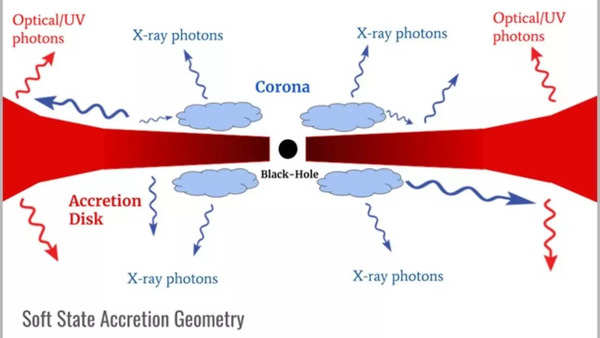
Accepted to be published in The Astrophysical Journal, the comprehensive study presents unique revelations about this cosmic phenomenon’s behaviour during its 2018 outburst.
Led by researchers from The Inter-University Centre for Astronomy and Astrophysics (IUCAA) in Pune, the team includes collaborators from institutions across India, the UK, UAE, and Poland.
“MAXI J1820+070 garnered tremendous interest from the astronomy community when it was first detected by the Monitor of All-sky X-ray Image (MAXI) aboard the International Space Station (ISS) in 2018, emerging as an exceptionally bright X-ray source. Numerous subsequent observation campaigns probed the system across the electromagnetic spectrum,” Isro said.
Capitalising on AstroSat’s X-ray and UV instruments, researchers captured both soft and hard X-ray emissions alongside far UV radiation, assembling a detailed portrait of MAXI J1820+070’s inner and outer regions.
“Further incorporating optical data and soft X-ray data from international facilities, the team gained remarkable insight into the system’s intricate dynamics. The study reveals fascinating findings regarding the binary’s accretion states, characterised by the position of its accretion disk,” Isro said.

It added that advanced analysis also enabled determination of the black hole’s spin, elucidating its fundamental properties. Moreover, the research establishes an intriguing connection between emissions from the inner and outer accretion flow components.
Prof Gulab Dewangan, a faculty member at IUCAA, says “AstroSat provides unique capability for multi-wavelength observations of X-ray binaries and other cosmic sources, and studies like this are indispensable for unravelling the complexities of these cosmic systems.”
Prof Dipankar Bhattacharya, chairperson of the AstroSat Science Working Group and a co-author of this study, said this was the first time the full capability of all the co-pointed instruments in AstroSat have been used in unison, supplemented by ground-based observations, and the results are fascinating.
“I am happy to be a part of this unique investigation of one of the most interesting Black Hole sources discovered in recent times,” Bhattacharya said.


